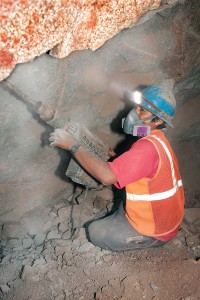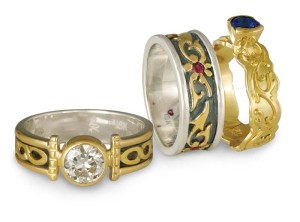How we got here

We know much of the material from which we make our product is a commodity, but our customers do not see jewellery the same way as say, lumber or oil. Its value is emotional, or as Martin Rapaport wrote in an article several years ago, jewellery possesses “spiritual sparkle.”
I have been concerned about where the materials I use come from since I started my company 16 years ago. I attended Rapaport’s first fairtrade jewellery meeting in 2006 and the seminal, cross-sector ethical jewellery Madison Dialogue gathering at the World Bank in Washington D.C. the following year. I’ve led working groups, published numerous articles on ethical manufacturing, and run Fair Jewelry Action USA, a network of jewellers, manufacturers, and mining groups interested in ethical sourcing. Over the years, however, I’ve noticed the supply chain has changed little in most respects.
Nearly all the 100 million small-scale miners around the world supplying 15 to 30 per cent of newly mined gold and up to 80 per cent of all coloured gemstones live in abject poverty. People are still buying diamonds for engagement rings sourced from countries where human rights atrocities are common. Now, unfortunately, some of these diamonds, sourced from Zimbabwe, for example, are certified ‘conflict-free.’
Undeniably, media coverage over the past five years on all things ‘conflict,’ ‘blood,’ and ‘dirty’ in the jewellery industry has created a rising tide of consumer awareness. To counter this negative exposure or ‘attack on our business,’ many jewellers continue to follow their tried and true solution, which still works well: marketing based upon cost, value, romance, and seduction.
Yet many in the trade are increasingly concerned about the business and moral implications of sourcing. Large companies facing extremely complex international supply chains—many of which they have little control over—are perplexed as to how to trace materials from mine to market. As a jeweller and manufacturer myself, I know it is not easy—my company has more than 3000 pieces of inventory.
Where to go

The good news is that, unlike five years ago, we now have some very good options. Coloured gems sourced according to fairtrade principles and standards are now available, while consumers are drawn to Canadian diamonds for their conflict-free status. It is even possible to get melee traceable to Australian and Canadian sources. Products made of 100 per cent recycled materials are easily obtainable, including ‘renewed’ (i.e. recycled) diamonds.
I know from my own experience that using recycled metals has enhanced my brand; I find consumers appreciate a jeweller who takes a proactive stance toward the environment and human rights issue associated with sourcing. Best of all, jewellery created with materials from transparent and traceable supply chains are not necessarily more expensive, since competition is still a concern and companies have adjusted their operations as much as possible to survive in the mainstream market.
The introduction of fairtrade gold in February 2011 caused significant media attention. Since then, 52 jewellers around the world (including two in Canada) have been licensed to sell this metal, which is mined by small-scale mining co-operatives in countries like Peru, and third-party audited to be fair and environmentally responsible. According to Greg Valerio, the jeweller activist who pioneered fairtrade gold, manufacturers purchased approximately £700,000 ($1.1 million Cdn) of fairtrade gold in its first year, putting about 10 per cent of that back into the communities that mined it in the form of schools and health clinics.
“Ten years ago no one in the U.K. and Ireland gave any notice to ethical issues in jewellery. Now it is the dominant discussion,” said Valerio, founder of Cred Jewellery in the U.K and co-founder of Fair Jewelry Action. “We have discovered a pound of truth is worth a million pounds of PR.”
Given the smaller supply of fairtrade and fairmined gold, it is easy to understand why this material is deemed the “most precious gold in the world.” In the U.K. where the movement is quite strong, a wave of positive publicity around fairtrade and fairmined gold has created a lot of momentum, even though it is about 10 to 15 per cent more expensive than ordinary gold. In North America, its profile is far lower. While many people understand fairtrade coffee or chocolate, gold is entirely different. Â
The challenge for those who sell it, including myself, is to educate the customer. The Fairtrade Labeling Organization (FLO), with which I am personally involved, is working to develop a plan to broadly introduce fairtrade and fairmined gold to the North American market later this year.Â





